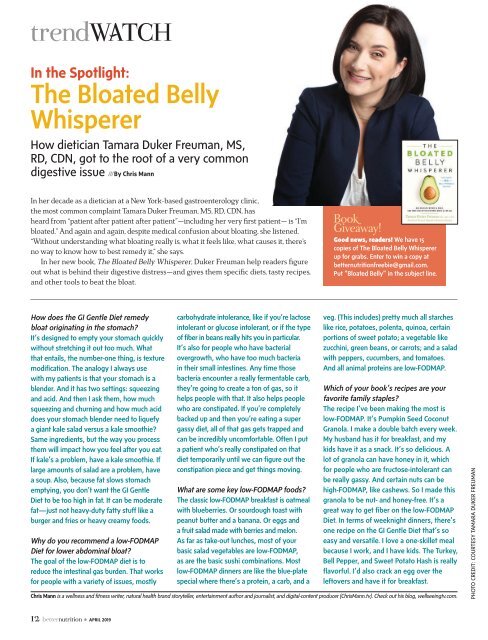Create successful ePaper yourself
Turn your PDF publications into a flip-book with our unique Google optimized e-Paper software.
trendWATCH<br />
In the Spotlight:<br />
The Bloated Belly<br />
Whisperer<br />
How dietician Tamara Duker Freuman, MS,<br />
RD, CDN, got to the root of a very common<br />
digestive issue /// By Chris Mann<br />
In her decade as a dietician at a New York-based gastroenterology clinic,<br />
the most common complaint Tamara Duker Freuman, MS, RD, CDN, has<br />
heard from “patient after patient after patient”—including her very first patient— is “I’m<br />
bloated.” And again and again, despite medical confusion about bloating, she listened.<br />
“Without understanding what bloating really is, what it feels like, what causes it, there’s<br />
no way to know how to best remedy it,” she says.<br />
In her new book, The Bloated Belly Whisperer, Duker Freuman help readers figure<br />
out what is behind their digestive distress—and gives them specific diets, tasty recipes,<br />
and other tools to beat the bloat.<br />
Book<br />
Giveaway!<br />
Good news, readers! We have 15<br />
copies of The Bloated Belly Whisperer<br />
up for grabs. Enter to win a copy at<br />
betternutritionfreebie@gmail.com.<br />
Put “Bloated Belly” in the subject line.<br />
How does the GI Gentle Diet remedy<br />
bloat originating in the stomach?<br />
It’s designed to empty your stomach quickly<br />
without stretching it out too much. What<br />
that entails, the number-one thing, is texture<br />
modification. The analogy I always use<br />
with my patients is that your stomach is a<br />
blender. And it has two settings: squeezing<br />
and acid. And then I ask them, how much<br />
squeezing and churning and how much acid<br />
does your stomach blender need to liquefy<br />
a giant kale salad versus a kale smoothie?<br />
Same ingredients, but the way you process<br />
them will impact how you feel after you eat.<br />
If kale’s a problem, have a kale smoothie. If<br />
large amounts of salad are a problem, have<br />
a soup. Also, because fat slows stomach<br />
emptying, you don’t want the GI Gentle<br />
Diet to be too high in fat. It can be moderate<br />
fat—just not heavy-duty fatty stuff like a<br />
burger and fries or heavy creamy foods.<br />
Why do you recommend a low-FODMAP<br />
Diet for lower abdominal bloat?<br />
The goal of the low-FODMAP diet is to<br />
reduce the intestinal gas burden. That works<br />
for people with a variety of issues, mostly<br />
carbohydrate intolerance, like if you’re lactose<br />
intolerant or glucose intolerant, or if the type<br />
of fiber in beans really hits you in particular.<br />
It’s also for people who have bacterial<br />
overgrowth, who have too much bacteria<br />
in their small intestines. Any time those<br />
bacteria encounter a really fermentable carb,<br />
they’re going to create a ton of gas, so it<br />
helps people with that. It also helps people<br />
who are constipated. If you’re completely<br />
backed up and then you’re eating a super<br />
gassy diet, all of that gas gets trapped and<br />
can be incredibly uncomfortable. Often I put<br />
a patient who’s really constipated on that<br />
diet temporarily until we can figure out the<br />
constipation piece and get things moving.<br />
What are some key low-FODMAP foods?<br />
The classic low-FODMAP breakfast is oatmeal<br />
with blueberries. Or sourdough toast with<br />
peanut butter and a banana. Or eggs and<br />
a fruit salad made with berries and melon.<br />
As far as take-out lunches, most of your<br />
basic salad vegetables are low-FODMAP,<br />
as are the basic sushi combinations. Most<br />
low-FODMAP dinners are like the blue-plate<br />
special where there’s a protein, a carb, and a<br />
veg. (This includes) pretty much all starches<br />
like rice, potatoes, polenta, quinoa, certain<br />
portions of sweet potato; a vegetable like<br />
zucchini, green beans, or carrots; and a salad<br />
with peppers, cucumbers, and tomatoes.<br />
And all animal proteins are low-FODMAP.<br />
Which of your book’s recipes are your<br />
favorite family staples?<br />
The recipe I’ve been making the most is<br />
low-FODMAP. It’s Pumpkin Seed Coconut<br />
Granola. I make a double batch every week.<br />
My husband has it for breakfast, and my<br />
kids have it as a snack. It’s so delicious. A<br />
lot of granola can have honey in it, which<br />
for people who are fructose-intolerant can<br />
be really gassy. And certain nuts can be<br />
high-FODMAP, like cashews. So I made this<br />
granola to be nut- and honey-free. It’s a<br />
great way to get fiber on the low-FODMAP<br />
Diet. In terms of weeknight dinners, there’s<br />
one recipe on the GI Gentle Diet that’s so<br />
easy and versatile. I love a one-skillet meal<br />
because I work, and I have kids. The Turkey,<br />
Bell Pepper, and Sweet Potato Hash is really<br />
flavorful. I’d also crack an egg over the<br />
leftovers and have it for breakfast.<br />
Chris Mann is a wellness and fitness writer, natural health brand storyteller, entertainment author and journalist, and digital-content producer (ChrisMann.tv). Check out his blog, wellseeingtv.com.<br />
PHOTO CREDIT: COURTESY TAMARA DUKER FREUMAN<br />
12 • APRIL <strong>2019</strong>

















